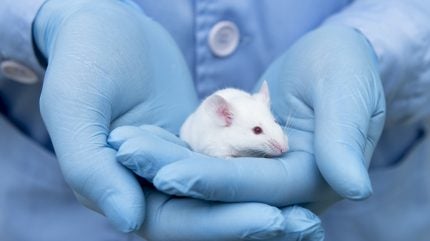
In a bid to prioritise more human-relevant models, the US Food and Drug Administration (FDA) has enforced a plan to phase out animal testing for monoclonal antibodies (mAbs) in the preclinical stage, as well as other drugs applying for Investigational New Drug (IND) status.
Publicised in April 2025, the FDA’s framework is designed to improve drug safety while expediting the review process, which the regulator believes will lower both research and development (R&D) costs and drug prices.

Discover B2B Marketing That Performs
Combine business intelligence and editorial excellence to reach engaged professionals across 36 leading media platforms.
The European Commission (EC) is taking a similar approach, debuting its roadmap – Directive 2010/63/EU1 – for animal testing phase-out just a few days before the FDA’s enforcement. Though the agency does not currently require developers to remove animal testing from their roster, its goal is to “protect animals as sentient beings” by gradually reducing animal use for research and regulatory purposes.
The requirement follows an industry push to develop assays that more accurately predict human responses to drugs than animal models, which have been the gold standard in early-stage drug development for centuries. Though in silico and in vitro assays are sparking interest in the discovery space, Steve Bulera, executive director of GLBL Toxicology at Charles River Laboratories, tells Pharmaceutical Technology that the sector has a fair few hurdles to overcome before this becomes standard practice.

This interview has been edited for length and clarity.
Annabel Kartal-Allen (AKA): Do you think that alternative methods are or will be better than animal testing?
Steve Bulera (SB): One day, these methods will likely be better than animal testing, but they are not there yet. Though the predictive power of new approach methodologies (NAMs) has greatly improved in the last five to ten years, animal models are still the gold standard test for many drug-induced adverse events. Currently, NAMs are mainly good for picking better candidates for development in animal models, so there is still a way to go.

US Tariffs are shifting - will you react or anticipate?
Don’t let policy changes catch you off guard. Stay proactive with real-time data and expert analysis.
By GlobalDataAKA: Are there any misconceptions around alternative testing?
SB: I think people believe that the industry has already developed all the in vitro assays that would allow us to phase out animals tomorrow and be able to predict human safety, but that is currently untrue. People also underestimate the time they take to develop, as robust assays capable of predicting patient safety can take years to validate and build trust.
AKA: What are the most promising alternative testing methods, and why?
SB: Though everybody loves ‘sexy science’ as I call it, the industry must look at organ-on-a-chip models and spheroids, as well as organised 2D and 3D cultures. You will need to have the right tool to answer the question at hand, which means that there will likely be a panel of different assays employing different technologies suitable for certain contexts.
Right now, a lot of industry folk are focusing on spheroids or organoids because they’re more representative of an organ than 2D and 3D cell cultures, but they’re also a lot cheaper than more sophisticated technologies like organ-on-a-chip.
AKA: What should companies consider when implementing alternative testing?
SB: To implement alternative testing methods on a wide scale, it’s going to take time, research and money. There will have to be a keen focus on validation, which will allow researchers to show what happens when an alternative assay is exposed to a drug.
When developing assays, there are several costs that stem from R&D – most of which come from the creation of new technologies. Since this process can be expensive, initial investments will be high – but once they’re developed, companies can focus on scaling up their product, automating the manufacturing process and enhancing throughput to drive costs down.
In the future, we will likely use a combination of technologies like next-generation sequencing (NGS) and toxicogenomics to understand the signal transduction pathways and cellular mechanisms behind a drug’s efficacy. By using markers obtained from these technologies as predictors of future outcomes, we can reduce study timelines in the long run.
AKA: Do you think a hybrid approach of combining alternative and animal-based testing models will be the way forward for now?
SB: I think this approach will be popular for a period, as in vitro tests will be run in parallel with standard animal tests to show that they are just as good – if not better – at predicting the genotoxic outcome of a drug in a patient. People are going to want to see that data before using alternative methods.
AKA: What are the hurdles associated with the implementation of alternative testing methods, and how can they be overcome?
SB: Currently, many companies are not fully sure of what regulatory agencies will want, accept or try. After talking to our clients, Charles River found that the majority do not believe they can develop these methods by themselves. This means there is going to have to be a group effort where companies form partnerships to keep costs down and accelerate development timelines.
Ideally, companies would share everything they have on the assay development process – the successes, failures and discontinued compounds. However, this might pose a challenge, as companies are unlikely to share an assay they have spent millions to create.
The validation issue also persists, as company A may validate its assay completely differently from company B – meaning a regulator must spend a lot of time and effort figuring out if either method is ‘good’ or ‘bad’. By banding together and establishing standardised methods, we could streamline the process, though this would require the industry to approach things differently.
Currently, the industry is trying to feel its way through this, as we do not yet know how to incorporate these types of assays into operations, as there is not an overabundance of them available to predict human safety. Regulators are also going to have to figure out how to use this information to make a decision on a drug’s development.
AKA: Following the FDA’s recent plans to phase out mAb animal testing, what modality do you think might come next?
SB: To clarify, I think we will be able to phase out certain aspects of animal testing for a selection of mAbs – namely those that work through well-known signal transduction pathways or those that act on a pathogen that is proven to be unable to bind to anything in a human. However, most pharmaceutical companies are developing drugs that act on novel targets. Since these will likely not have been studied in-depth before, companies will be hard-pressed to do no animal testing in this context. I believe we need to refer to them as use cases.
It makes sense that the FDA has chosen to phase out animal testing in mAbs first, as they are very specific, and we know we can characterise them. Moving forward, I think one-drug modalities with highly specific interactions, such as oligonucleotides and bivalent antibodies, would be next in line.
Removing animal testing from small molecule development will be particularly challenging, as you would have to think about all the alternative methods you need for every organ it impacts. They are also broken down in the body, meaning metabolites will have to be accounted for in testing.





